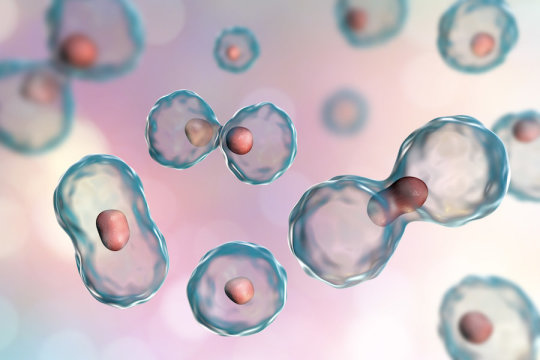[ad_1]
Working with bacteria, a multidisciplinary team at the University of California San Diego has provided new insight into a longstanding question in science: What are the underlying mechanisms that control the size of cells?
Nearly five years ago a team led by Suckjoon Jun, a biophysicist at UC San Diego, discovered that cell size is controlled by a fundamental process known as “the adder,” a function that guides cells to grow by a fixed added size from birth to division. Yet mysteries remained about the mechanisms behind the process, leading to a scientific race to find out.
Publishing their work in the May 16 issue of Current Biology, Jun, lead authors Fangwei Si and Guillaume Le Treut and their colleagues describe the inner workings of the adder. They found that the process, also known as “size homeostasis,” boils down to two required components: balanced synthesis of specific biological ingredients for cell division, including certain proteins; and a critical threshold that initiates the adder process when a sufficient number of such proteins accumulates. The adder process then follows from these two requirements, the scientists say.
“It’s a very robust mechanism because each cell is guaranteed to reach its target cell size whether it is born large or small,” said Jun, an associate professor in the Division of Biological Science’s Section of Molecular Biology and the Division of Physical Sciences’ Department of Physics. “The bottom line is that we found the adder is exclusively determined by some key proteins involved in cell division.”
Although the researchers discovered the mechanisms in bacteria Escherichia coli (E. coli) and Bacillus subtilis (B. subtilis), they believe the process is general across many life forms.
Jun says the research team, made up of biologists, physicists and engineers, cracked the adder case after years of attempting an array of investigative methods and experimental approaches.
“Cell size homeostasis is a fundamental biological question and to our knowledge this is the first time we finally understand its mechanistic origin,” said Jun. “We would not have been able to solve this with pure physics or pure biology. It was a very multidisciplinary approach.”
The research team is now investigating whether the quantitative and mechanistic framework underlying the adder applies to other models such as yeast and cancer cells.
In addition to Si, Le Treut and Jun, coauthors of the paper include John Sauls of UC San Diego’s Department of Physics; and Stephen Vadia and Petra Anne Levin of Washington University in St. Louis.
Funding for the study was provided by the Paul G. Allen Family Foundation, the Pew Charitable Trusts, a National Science Foundation CAREER grant (MCB-1253843) and National Institutes of Health (R01 GM118565-01 and R35-400 GM127331.
Story Source:
Materials provided by University of California – San Diego. Original written by Mario Aguilera. Note: Content may be edited for style and length.
[ad_2]















